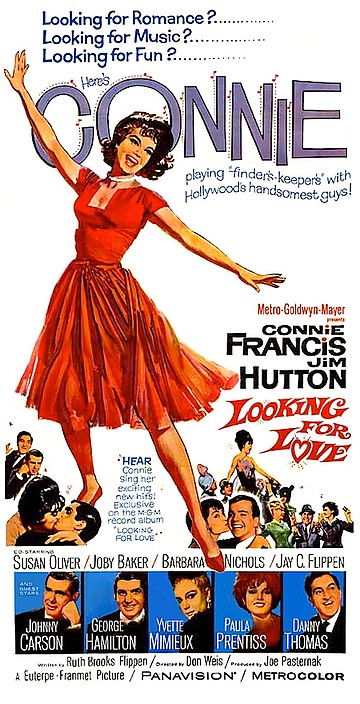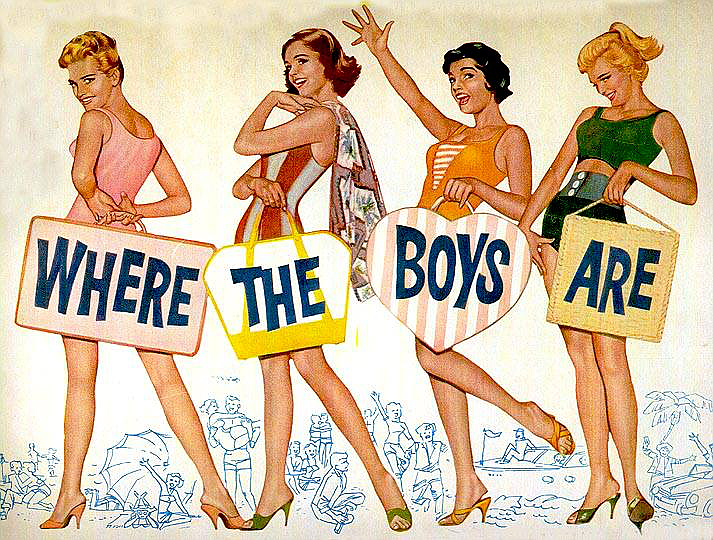 Facebook
Facebook
 X
X
 Instagram
Instagram
 TikTok
TikTok
 Youtube
Youtube

Antenna TV began airing nightly reruns of The Tonight Show starring Johnny Carson in January. Hour-long shows originally broadcast between 1980 and 1992 run Monday through Friday at 8 p.m. and 11 p.m. 90 minute episodes from the ’70s air Saturday and Sunday nights at 7 p.m. and 10:30 p.m.
According to the official Johnny Carson website, only 33 complete episodes exist from the period between October 1, 1962, Johnny’s first show, and May 1, 1972. Video tape was costly, film even more so. To save money, the 2-inch quads used to record the shows were commonly taped over. In 1973, Carson personally paid to have each show preserved for posterity.

Carson appeared in only one movie, a cameo as “Himself” in the Connie Francis vehicle Looking for Love. Love was to Carson what The Horn Blows at Midnight was to Jack Benny. In Benny’s defense, Horn, directed by Raoul Walsh, is actually a very entertaining fantasy with the comedian starring as an angel sent to Earth on New Year’s Eve to trumpet the arrival of the apocalypse. The critical and commercial flop became the punchline of his career.
Looking for Love had come up so many times during the course of Carson’s celebrity interviews that I decided to see if Buddy Hackett’s jabs about Johnny’s performance were true. Sure enough, a burn-on-demand copy was available through the Warner Archives.
It wasn’t as if Hollywood purposely overlooked Carson’s acting ability. Johnny was an early choice to play Rob Petrie on what would become The Dick Van Dyke show. Martin Scorsese wanted him for the Jerry Langford role in The King of Comedy, but Carson refused, saying, “You know that one take is enough for me.” And somewhere in the back of my mind a thought lingers. Wasn’t Carson Jackie Susann’s first choice to play the titular lead in the delightfully dreadful, The Love Machine? Can anyone confirm or deny?
Looking for Love was Connie’s third of her four musical comedies at Metro and the only one that doesn’t have the word “boy” in the title. By 1964, Hollywood had pretty much thrown in the towel as far as television was concerned, and studios began openly sleeping with the enemy. Not only is Looking for Love crammed with popular small screen personalities of the day (Carson, Danny Thomas, Jesse White, Joby Baker) and cute (overly rehearsed) on-set mishaps, the structure, pace and TV-safe ’Scope composition are strictly for the boob-tube.
It’s easy to understand how scenarist Ruth Brooks Flippen (wife of High Priest of character acting, Jay C.) would eventually write on ’60s babysitters like The Brady Bunch and The New Scooby Doo Movies. The big heartbreaker is the anamorphic frames — with characters crowded to the center so as to not look awkward in pan-and-scan playback on The Sunday Night Movie — lensed by Vincente Minnelli mainstay Milton Krasner (Home From the Hill, Two Weeks in Another Town). It’s a sad waste of anamorphosis.

Stardom eluded Libby Caruso (Francis) for an entire month, so she decided to get out of the music business and snare a man. Aside from her voice the her “Lady Valet,” a glorified clothes hanger of her own invention, Libby’s main talent was sniffing out Mr. Right. Enter Jim Hutton, a co-worker into TNT — “Tall ’n’ Top-Heavy” — who lands Libby a spot on the Tonight Show to tout her creation. The product flops, but her singing connects and for another hour we watch Libby slalom her way through a light powder of familiar supporting players in search of true love. Hit pause if nature calls. An ill-timed tinkle could cause you to miss Carson’s entire performance.
The film was made to cash in on the success of earlier Francis/Hutton vehicles, most notably the entertaining, guiltiest of all guilty pleasures, Where the Boys Are. As sociologically and cinematically backwards as that film is, it plays like a Noel Coward bedroom farce when compared to this set-bound stiff.
An exterior view of a neon-drenched ’60s supermarket is but a tease. No sooner is the measly establishing shot dangled before us then it’s back to the studio. Where the Boys Are alumni George Hamilton, Yvette Mimieux, and the vastly underrated Paula Prentiss appear briefly, bringing adding name recognition to the poster and nothing more.
Connie Francis was a firecracker. She had the neurotic frailty of a young Judy Garland, Ethel Merman’s pipes, and the comedic subtlety of a Danny Thomas. Well, two outta three ain’t bad. Pert and delightfully ditzy in the light comedy (comedy-lite?) passages, Connie proved capable of showing her range even in trash like this. She could have been a contender had it not been for a horrifying assault in a Howard Johnson’s motel room.
Director Don Weis had come through in the past (I Love Melvin, The Adventures of Hajji Baba), but this time his greatest feat of strength was punching the Metro time clock. Impress me once, good for you. Disappoint me after an imposing introduction, and I’ll probably still keep giving you the benefit of the doubt in hopes of a return to form. After all, other than Carson, what do you think drew an old auteurist like me to fluff like this in the first place?


Antenna TV began airing nightly reruns of The Tonight Show starring Johnny Carson in January. Hour-long shows originally broadcast between 1980 and 1992 run Monday through Friday at 8 p.m. and 11 p.m. 90 minute episodes from the ’70s air Saturday and Sunday nights at 7 p.m. and 10:30 p.m.
According to the official Johnny Carson website, only 33 complete episodes exist from the period between October 1, 1962, Johnny’s first show, and May 1, 1972. Video tape was costly, film even more so. To save money, the 2-inch quads used to record the shows were commonly taped over. In 1973, Carson personally paid to have each show preserved for posterity.

Carson appeared in only one movie, a cameo as “Himself” in the Connie Francis vehicle Looking for Love. Love was to Carson what The Horn Blows at Midnight was to Jack Benny. In Benny’s defense, Horn, directed by Raoul Walsh, is actually a very entertaining fantasy with the comedian starring as an angel sent to Earth on New Year’s Eve to trumpet the arrival of the apocalypse. The critical and commercial flop became the punchline of his career.
Looking for Love had come up so many times during the course of Carson’s celebrity interviews that I decided to see if Buddy Hackett’s jabs about Johnny’s performance were true. Sure enough, a burn-on-demand copy was available through the Warner Archives.
It wasn’t as if Hollywood purposely overlooked Carson’s acting ability. Johnny was an early choice to play Rob Petrie on what would become The Dick Van Dyke show. Martin Scorsese wanted him for the Jerry Langford role in The King of Comedy, but Carson refused, saying, “You know that one take is enough for me.” And somewhere in the back of my mind a thought lingers. Wasn’t Carson Jackie Susann’s first choice to play the titular lead in the delightfully dreadful, The Love Machine? Can anyone confirm or deny?
Looking for Love was Connie’s third of her four musical comedies at Metro and the only one that doesn’t have the word “boy” in the title. By 1964, Hollywood had pretty much thrown in the towel as far as television was concerned, and studios began openly sleeping with the enemy. Not only is Looking for Love crammed with popular small screen personalities of the day (Carson, Danny Thomas, Jesse White, Joby Baker) and cute (overly rehearsed) on-set mishaps, the structure, pace and TV-safe ’Scope composition are strictly for the boob-tube.
It’s easy to understand how scenarist Ruth Brooks Flippen (wife of High Priest of character acting, Jay C.) would eventually write on ’60s babysitters like The Brady Bunch and The New Scooby Doo Movies. The big heartbreaker is the anamorphic frames — with characters crowded to the center so as to not look awkward in pan-and-scan playback on The Sunday Night Movie — lensed by Vincente Minnelli mainstay Milton Krasner (Home From the Hill, Two Weeks in Another Town). It’s a sad waste of anamorphosis.

Stardom eluded Libby Caruso (Francis) for an entire month, so she decided to get out of the music business and snare a man. Aside from her voice the her “Lady Valet,” a glorified clothes hanger of her own invention, Libby’s main talent was sniffing out Mr. Right. Enter Jim Hutton, a co-worker into TNT — “Tall ’n’ Top-Heavy” — who lands Libby a spot on the Tonight Show to tout her creation. The product flops, but her singing connects and for another hour we watch Libby slalom her way through a light powder of familiar supporting players in search of true love. Hit pause if nature calls. An ill-timed tinkle could cause you to miss Carson’s entire performance.
The film was made to cash in on the success of earlier Francis/Hutton vehicles, most notably the entertaining, guiltiest of all guilty pleasures, Where the Boys Are. As sociologically and cinematically backwards as that film is, it plays like a Noel Coward bedroom farce when compared to this set-bound stiff.
An exterior view of a neon-drenched ’60s supermarket is but a tease. No sooner is the measly establishing shot dangled before us then it’s back to the studio. Where the Boys Are alumni George Hamilton, Yvette Mimieux, and the vastly underrated Paula Prentiss appear briefly, bringing adding name recognition to the poster and nothing more.
Connie Francis was a firecracker. She had the neurotic frailty of a young Judy Garland, Ethel Merman’s pipes, and the comedic subtlety of a Danny Thomas. Well, two outta three ain’t bad. Pert and delightfully ditzy in the light comedy (comedy-lite?) passages, Connie proved capable of showing her range even in trash like this. She could have been a contender had it not been for a horrifying assault in a Howard Johnson’s motel room.
Director Don Weis had come through in the past (I Love Melvin, The Adventures of Hajji Baba), but this time his greatest feat of strength was punching the Metro time clock. Impress me once, good for you. Disappoint me after an imposing introduction, and I’ll probably still keep giving you the benefit of the doubt in hopes of a return to form. After all, other than Carson, what do you think drew an old auteurist like me to fluff like this in the first place?
Comments